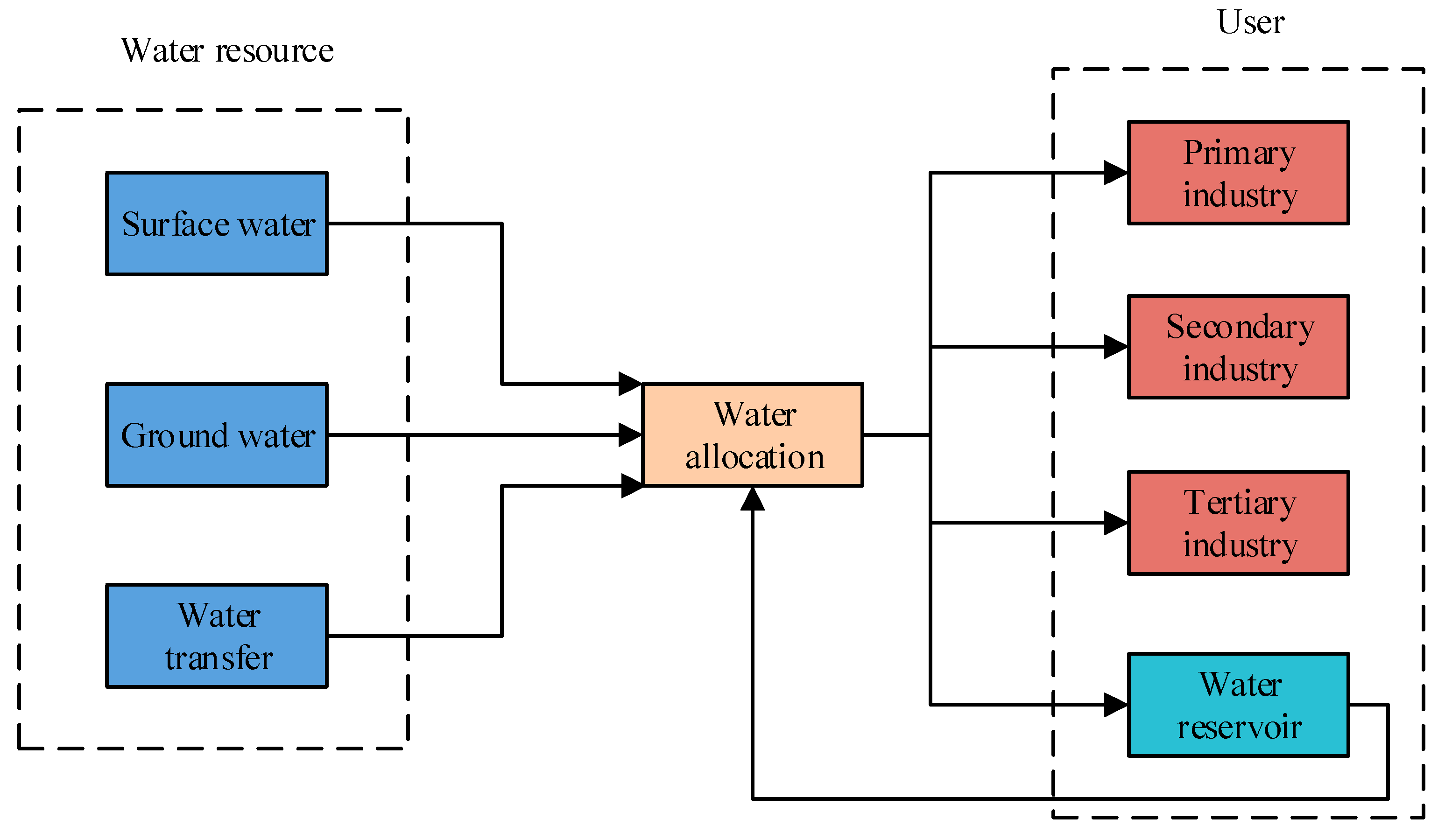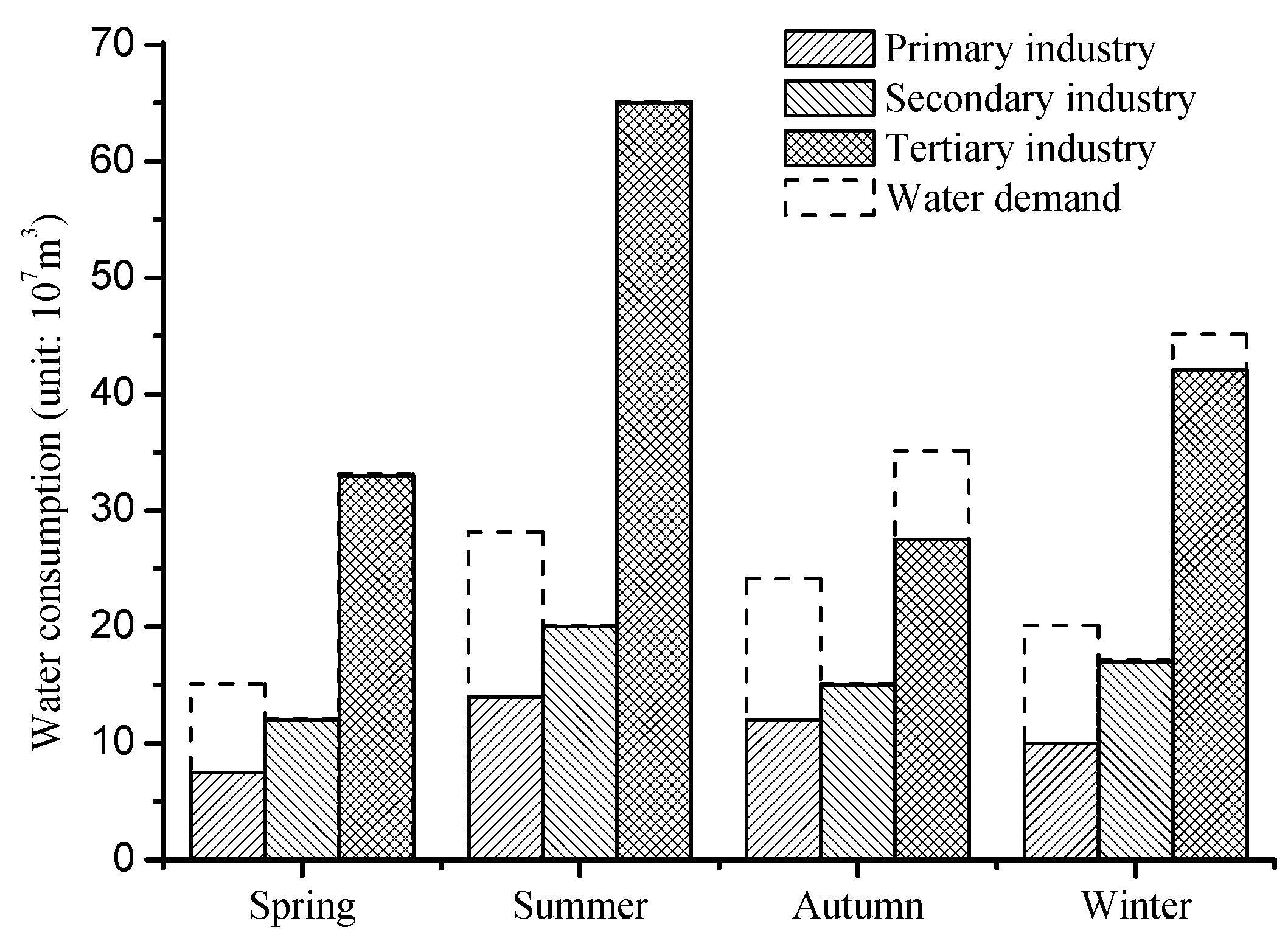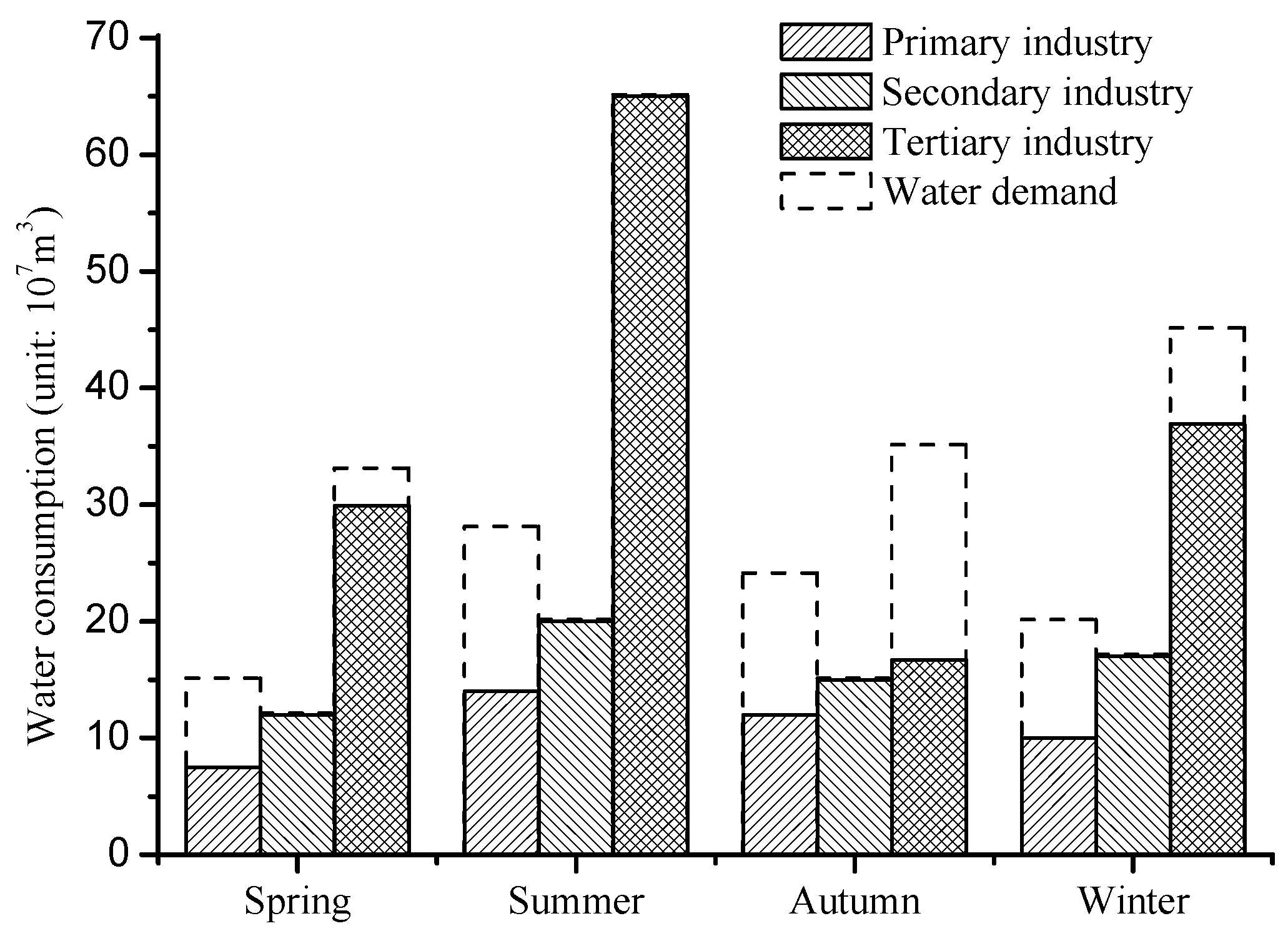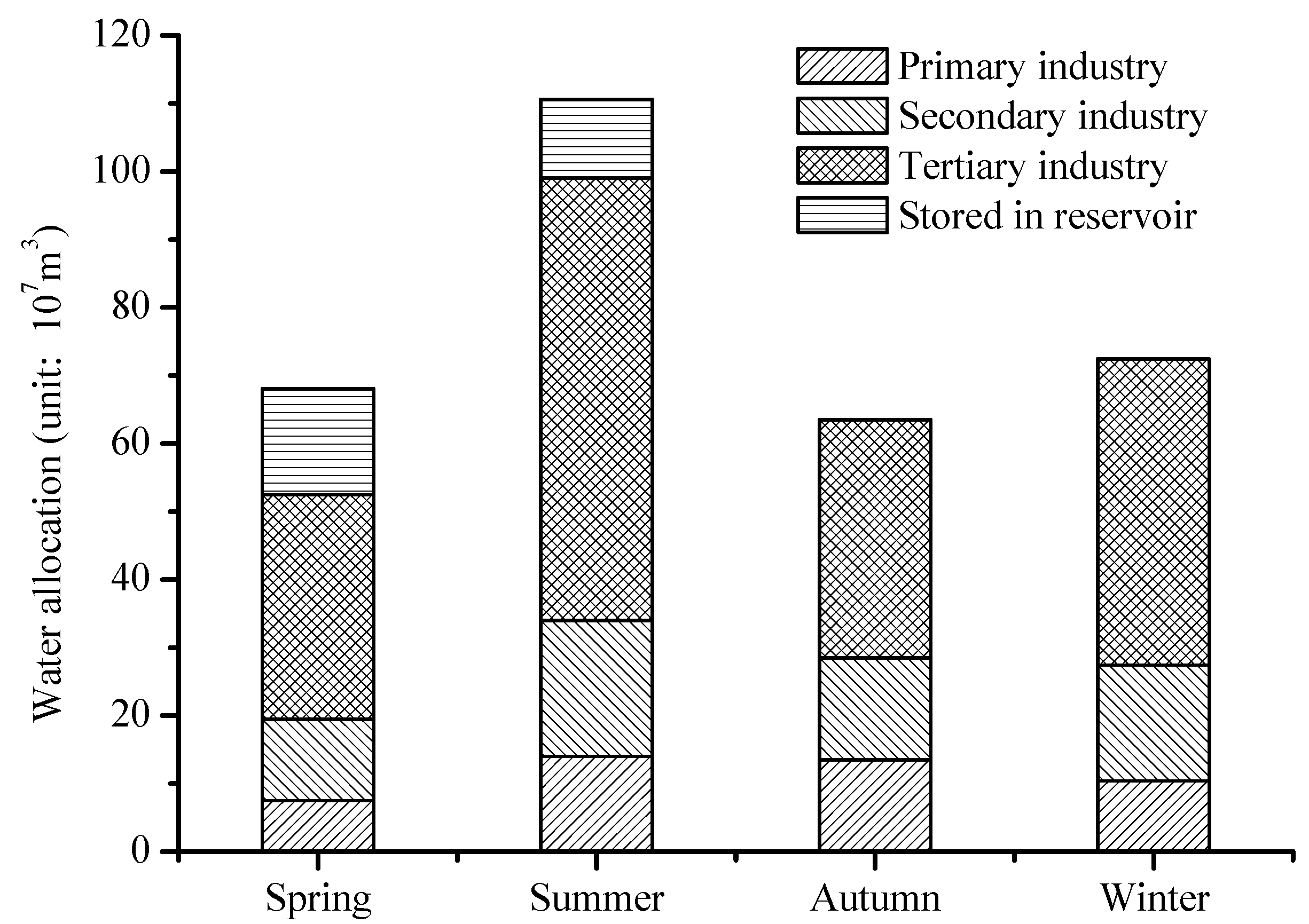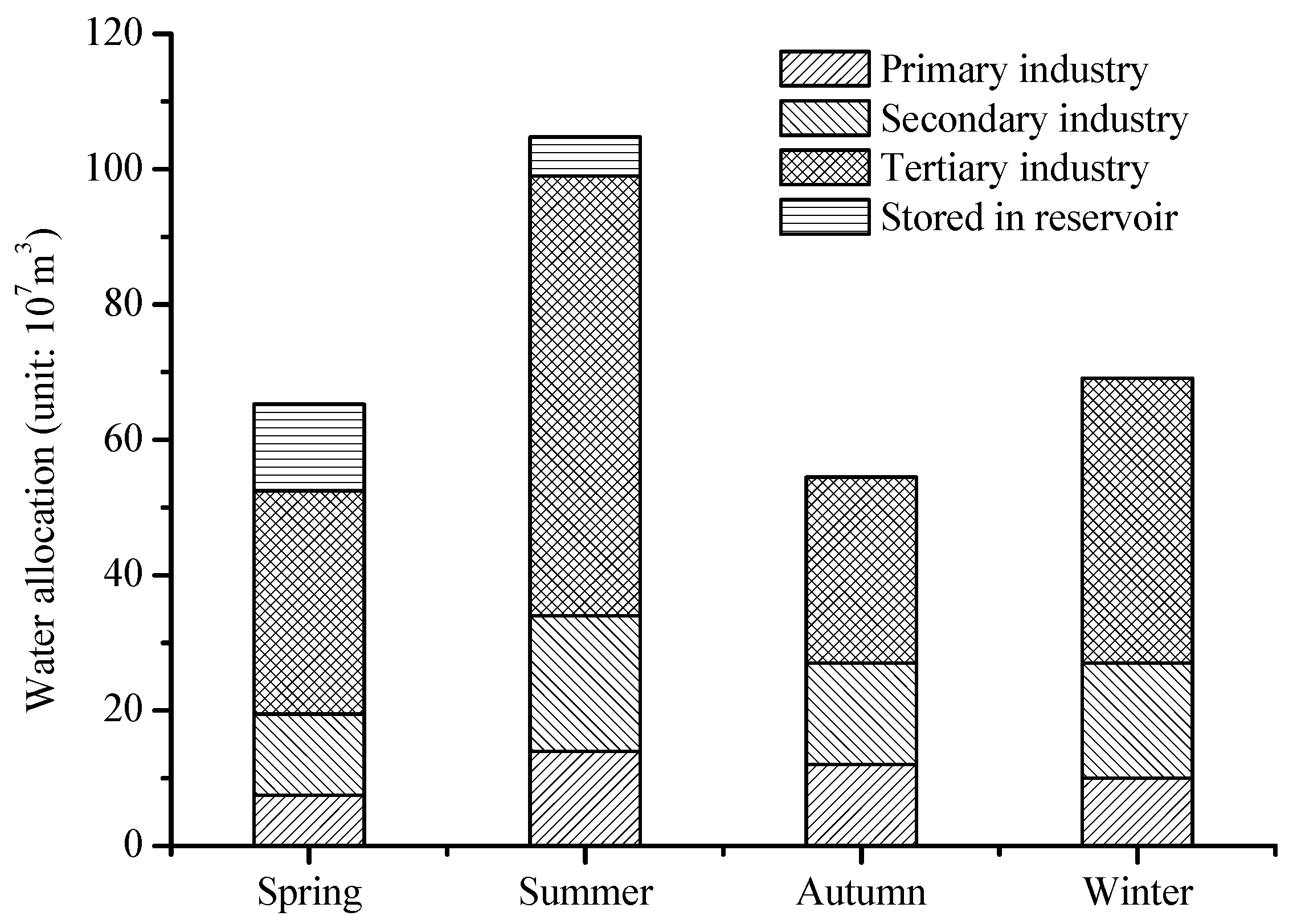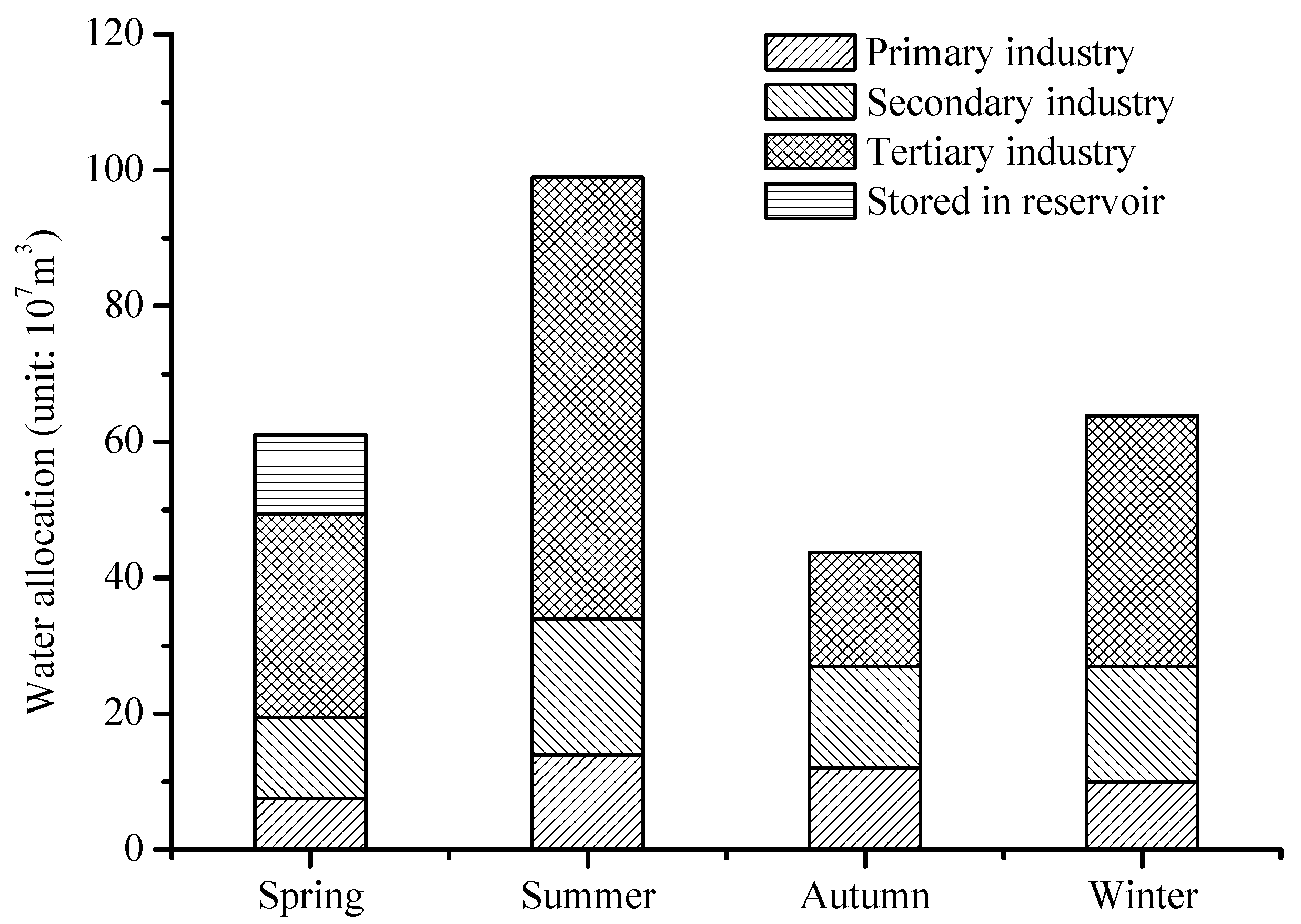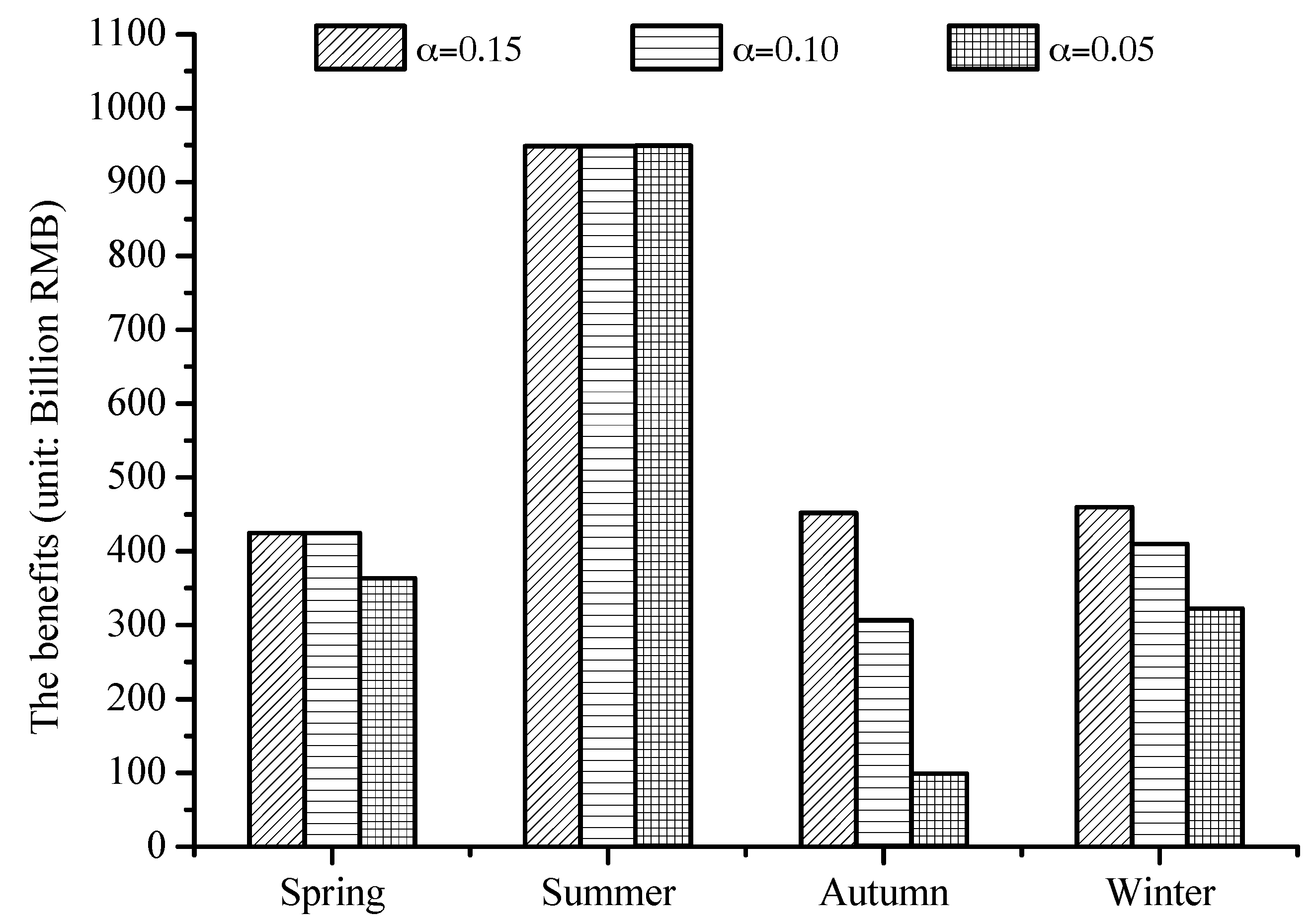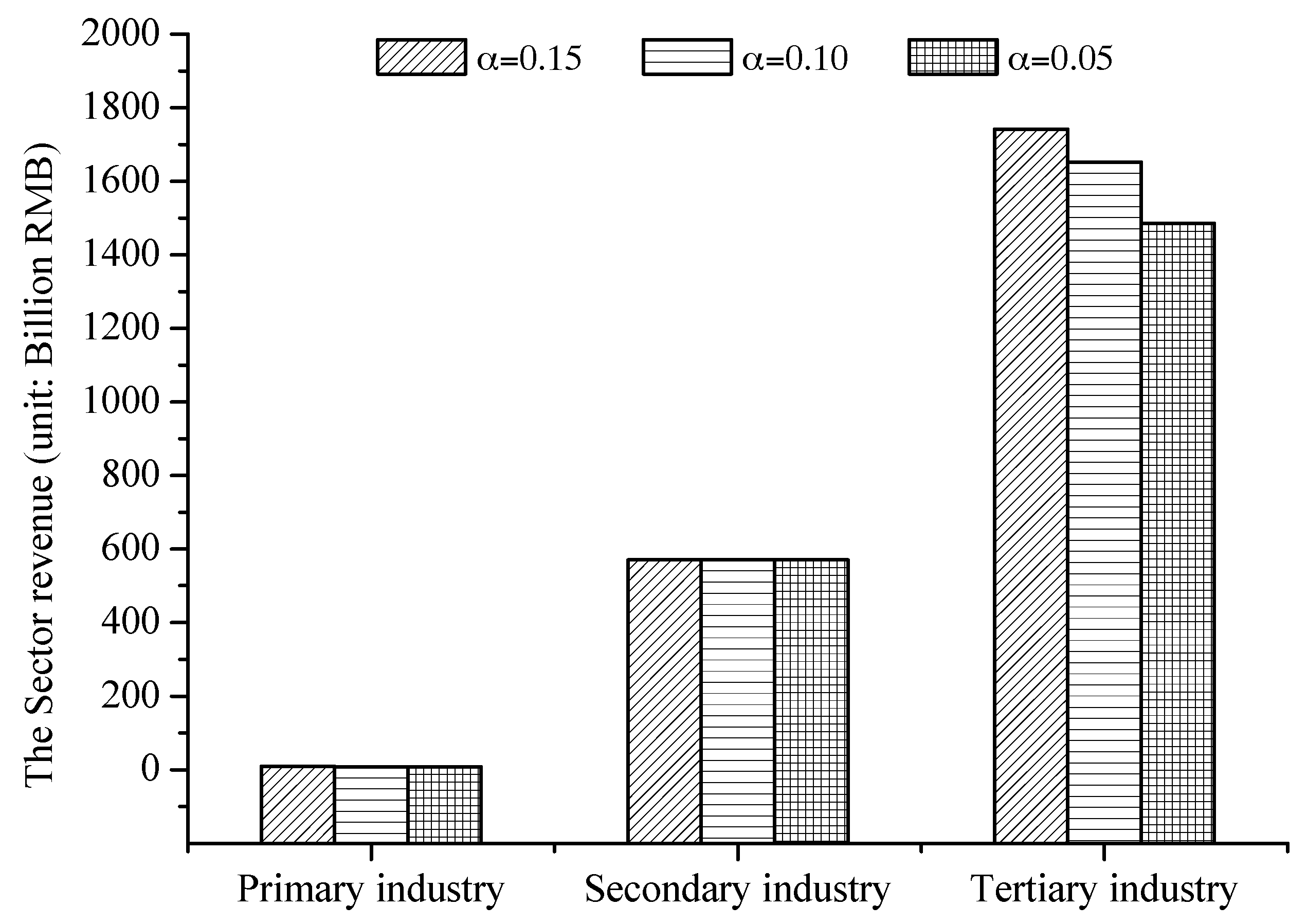1. Introduction
As an important natural resource, water is vital for supporting regional economic development and improving human-beings’ quality of life in densely populated areas (i.e., urban areas). In the last twenty years, with socioeconomic development, the acceleration of the urbanization process, and increasing population, water consumption has been obviously increasing in urban areas. In the past decades, water shortage problems have been relieved to a certain degree through protecting the existing water resources and exploiting new water resources. Nevertheless, due to the continuously increasing water demand and decreasing available water resources, the above two measures are becoming invalid [
1]
. Simultaneously, water shortage has seriously hindered the sustainable development of the Primary, Secondary, and Tertiary industry, which would pose a threat to social security and stability. In addition, there are still a variety of uncertainties existing in the water resources management system, such as available water amount, water consumption, multiple water sources, water conflicted users, and technical–economic parameters [
2]. These uncertain factors could be an obstacle to the formulation of rational water resources utilization, and lead to conflict-laden water allocation among multiple competing users [
3]. Therefore, the development of effective water resources management and protection schemes is desired in urban areas under uncertainty.
Previously, a number of inexact optimization methods were proposed for water resources allocation management [
4,
5,
6,
7,
8]. For example, based on chance-constrained programming, Huang (1998) presented an inexact-stochastic programming model for water quality management in an agricultural system, which could provide a trade-off between environmental objectives and an economic system [
9]. Li et al., 2008, advanced an interval-parameter robust quadratic programming method for regional water resources system management, where nonlinearities in the objective function were reflected by robust programming and interval quadratic programming [
10]. Guo et al., 2009, developed a two-stage fuzzy chance-constrained programming for water sources management under uncertainty, which could provide a desired water distribution plan by maximizing the system’s benefits [
11]. Li et al., 2009, proposed a hybrid fuzzy-stochastic model for agricultural water management, where fuzziness and randomness could be expressed as a multilayer scenario tree [
12]. Li et al., 2009, developed a multistage fuzzy-stochastic programming method for water resources allocation under uncertainty, in which a number of uncertainties were estimated as fuzzy sets and probability distributions [
13]. Xie et al., 2011, proposed an inexact-chance-constrained regional water quality management model, which can support policies of wastewater discharge and government investment. The model also provides compromises among economic benefits, system reliability and pollutant discharges [
14]. Xu et al., 2014, advanced a rank-based fuzzy optimization approach for agricultural farming water supply, which can help decision-makers to find cost-effective solutions under different probabilities of violation risk [
15]. Wang et al., 2015, proposed an inexact multi-stage dual-stochastic programming to deal with the problem of urban water resources allocation, where uncertainties could be addressed by incorporating interval-parameter programming, dual-stochastic programming and multi-stage optimization programming [
16].
From the above analysis, these inexact optimization methods can effectively solve some problems, including water allocation, trade-off between economic benefits and environmental objectives, and various uncertainties that exist in water resources management [
17]. For a water resources system coupled with multiple water sources, multiple water sources can provide a strong water guarantee and alleviate the contradiction between water supply and demand. However, multiple water sources will make the water supply system more complicated and bring about new requirements for local water resources allocation management. Therefore, how to balance the quantity of water intake from different water sources and identify the uncertainty in water-allocation planning still needs some special approaches in order to be resolved.
Among those proposed inexact optimization methods, chance-constraints programming can effectively address independent random variables in the constraints [
18]. Moreover, it can integrate other optimization methods within a general framework to tackle the uncertainty in water sources management. However, few studies have focused on the chance-constrained dynamic programming model for dispatching water resources from multi-water sources in urban areas.
Therefore, the objective of this study is to develop an interactive dynamic programming model which can provide optimal alternatives over multiple periods for decision-makers. Through incorporating the multiple sources with reservoir regulation and chance-constrained programming into the dynamic decision-making framework, the multi-water resources and multiple users chance-constrained dynamic programming (MMCDP) model can allocate multiple water sources to multiple users. MMCDP is useful for dealing with random variables in the constraints and generating the water supply allocation schemes coupled with the deployment of multiple water sources. Moreover, it can help decision-makers to not only acquire the maximum system net benefits under different violating constraints, but also identify desired compromises between the satisfaction degree of the economic benefits and the feasibility degree of the constraints.
4. Data Analysis of Results
The objective function is to maximize the total economic benefits. In this study, the decision-makers need to allocate water to multiple users. In order to maximize the system benefits, the decision-makers should also consider the benefit/penalty and random variables in available water resources. Through incorporating different probabilities of violating constraints into the MMCDP model, the results can provide a number of alternative decisions under different risk levels. In addition, the proposed MMCDP is able to reflect trade-offs between system benefits and associated risks caused by uncertainties in the objective function and constraints. Therefore, decision-makers can put forward a specific management plan based on their preferences to the resulting degrees of uncertainty.
Deficits would occur due to the insufficient obtainable water which is used to satisfy the water demand of each water-use industry. Under such a situation, the actual water allocation is the difference between the water demand and the associated water shortage (i.e., water supply = water demand − water shortage) under given available water resources with a related probability level. In the case of insufficient water supply, the water allocation should be firstly assigned to the Tertiary industry, secondly to the Secondary industry, and lastly to the Primary industry.
As shown in
Figure 2,
Figure 3 and
Figure 4, water consumption shows a significant seasonal trend, and the Tertiary industry is the biggest user of water. At the same time, the water consumption of the secondary industry is the least of all water-use sectors. From the results of water distribution, the industrial water accounts for merely 30~50% of the Tertiary industrial water. Simultaneously, the amount of water allocated to agriculture reaches the low limit of agricultural water supply in all probabilities of violating constraints during all planning periods. However, the amount of water allocated to the Secondary industry could meet the industrial demand in all planning periods. There are a number of seasons, wherein the water demand of the Tertiary industry cannot be satisfied.
Figure 2 indicates that the water consumption of the tertiary industry should be favored in the second quarter. This is because the highest profits would be generated by the Tertiary industry when its water demand can be satisfied; meanwhile, it would suffer the highest penalty if the water demand could not be delivered. In comparison, the Secondary industry and the Primary industry would correspond to relatively lower profits and lower penalties. To allocate water to the Tertiary industry, the benefits (e.g., tourism) may be much more significant during summer [
29]. As shown in
Figure 3 and
Figure 4, priority should be given to the water consumption of the Secondary industry in the third quarter. Because the Tertiary industry’s penalty caused by a lack of water is reduced significantly, the water supply should give priority to the Secondary industry and lastly to the Primary industry.
Based on the analysis of
Figure 2,
Figure 3 and
Figure 4 and
Table 5, the reason for the occasional water shortage in the Tertiary industry is that the amount of water demand and the penalty of the Tertiary industry is in off-season. Thus, the Secondary industry would take priority for water supply. According to the resulting solutions from the proposed method, decision-makers can make a compromised decision between allocating water to supply and storing water in the reservoir to guarantee water for the next quarter.
Under drought conditions, available water resources would reduce. As shown in
Figure 4, the amount of water supply in the Tertiary industry would decrease. The Primary industry and the Secondary industry would not change in water supply. As shown in
Table 8, a lower violating constraint would lead to relatively lower benefits. In the case of
, the optimal net benefit is 2064.8 billion RMB. Although a lower violating constraint would result in a lower risk of water shortage, there would be a potential waste of water resources when the level of obtainable water flow is high.
Generally, a higher violating constraint would lead to relatively higher benefits associated with a higher risk of penalty caused by water shortage. In comparison, when the value of violating constraint
becomes higher, the amount of water allocated to each user would increase over all phases (as shown in
Figure 2,
Figure 3 and
Figure 4). Meanwhile, the system benefit would increase with the reduction of system risk. Therefore, it is necessary for policymakers to make a trade-off between the system benefits and the associated risks.
Figure 5,
Figure 6 and
Figure 7 show the allocation of water sources among multiple users with different violating constraints
. In all probabilities for violating constraints, part of the water in the first quarter would be stored in the regulating reservoir to ensure the water supply of the next quarter. In comparison, the amount of water allocated to the Tertiary industry and the Secondary industry is much more than the Primary industry in each period. If the decision-maker does not store water in the reservoir, the water for the current quarter would be guaranteed. However, the overall benefits may be reduced. Meanwhile, in order to satisfy the requirements of water consumption in the next quarter, the decision-maker should store water in reservoirs. At this time, due to water shortage, the corresponding water-using departments will incur penalties.
Figure 8 shows that regardless of the probabilities of violating constraints α, the benefit in summer is always the most; the decision-makers should give priority to water supply in summer.
Figure 9 and
Table 8 show the benefits of different departments in all planning periods. The Secondary industry has the most stable benefit in all probabilities for violating constraints. The benefit of the Secondary industry would reach 570.3 billion RMB, accounting for a third of the Tertiary industry’s benefit. The agricultural benefit is the lowest in the three sectors, only being 9 billion RMB. Therefore, from the perspective of acquiring more benefit, the water supply should be firstly assigned to the Tertiary industry and lastly to the Primary industry. In the case of
, the optimal net benefit would be 2321.5 billion RMB. When
, the optimal net benefit is 2231.1 billion RMB. When
, the optimal net benefit is 2064.8 billion RMB. The proportion of water allocation of Primary, Secondary and Tertiary industry would be 40%, 38% and 22%, respectively. The results of the MMCDP model indicate that the Tertiary industry would consume the most water, followed by the Secondary industry and finally the Primary industry. In terms of economic benefits, the average benefit of the system in three different violating constraints would be 2205 billion RMB and 31.9% higher than the real benefit.
As shown in
Figure 2,
Figure 3,
Figure 4 and
Figure 9, the agricultural benefit would account for merely 1/60 of the Secondary industry’s and 1/180 of the Tertiary industry’s benefit. The minimum amount of water is allocated to the agricultural sector because the agricultural sector obtains the least benefit. As it has the least amount of water demand, the Secondary industry would obtain the most stable water supply of all departments. Simultaneously, not being affected by the seasons, its penalty would be constant in all planning periods.
In summary, decision-makers should give top priority to the water supply of the Tertiary industry in summer. In the other quarter, because the penalties of the Tertiary industry caused by water shortage will be less than the penalties of the Secondary industry, there would be no water shortage for the Secondary industry over the planning horizon except in summer. At the same time, decision-makers should appropriately reduce the water consumption in the other quarters to meet the water demand in summer. In terms of economic benefits, decision-makers can gain more revenue from the reasonable water allocation scheme provided by MMCDP. In addition, the optimized water-allocation schemes for different decision-makers would vary with the change of system objective (e.g., environmental benefits).
5 Conclusions
In this study, a multi-water resources and multiple users chance-constrained dynamic programming (MMCDP) model of water allocation has been developed by integrating chance-constrained programming into the dynamic programming decision-making framework. This model can not only solve the problem of probability distribution of water supply, but also provide a new idea for optimizing the allocation of a city’s water resources coupled with reservoir regulation.
The existing risk-based interactive multi-stage stochastic programming (RIMSP) approach can only deal with a single water source in the water resource allocation model. However, in the real world, model parameters are associated with multiple complexities. Urban water supply is no longer from a single source. Multiple water sources can provide a strong water guarantee and alleviate the contradiction between water supply and demand which will make the water supply system more complicated and put forward new requirements for local water resources allocation management. In addition, the water allocation schemes under extreme situations (drought and floods) were analyzed. The different schemes can support managers to obtain desired net system benefit and an effective water resources management plan. Comparing with the RIMSP model, the developed model can not only help decision-makers to evaluate the trade-offs between the economic objectives and the associated risks, but also make a balance amongst the deployment of multiple water sources.
The proposed MMCDP has been applied to a case study of Beijing’s water resources management to demonstrate its applicability. The water sources would include transferred water, groundwater and surface water. At the same time, Miyun Reservoir and Guanting Reservoir would act as extra water sources to re-participate water distribution in the new phase. The model can be used to optimize the water supply allocation of multiple water sources under different available water resources situations and generate the optimal allocation of water resources under different probabilities of violation . The obtained schemes can minimize the comprehensive cost of the system, maximize the expected benefit, and avoid the occurrence of system risk. Although this study is the first attempt at designing a water resources allocation system through MMCDP, the results suggest that the proposed method can be applied to other countries where freshwater resources are scarce, especially in those with reservoir systems. Moreover, it may be suitable for other inexact stochastic parameter researches, such as economic parameters, water flow and so on.
